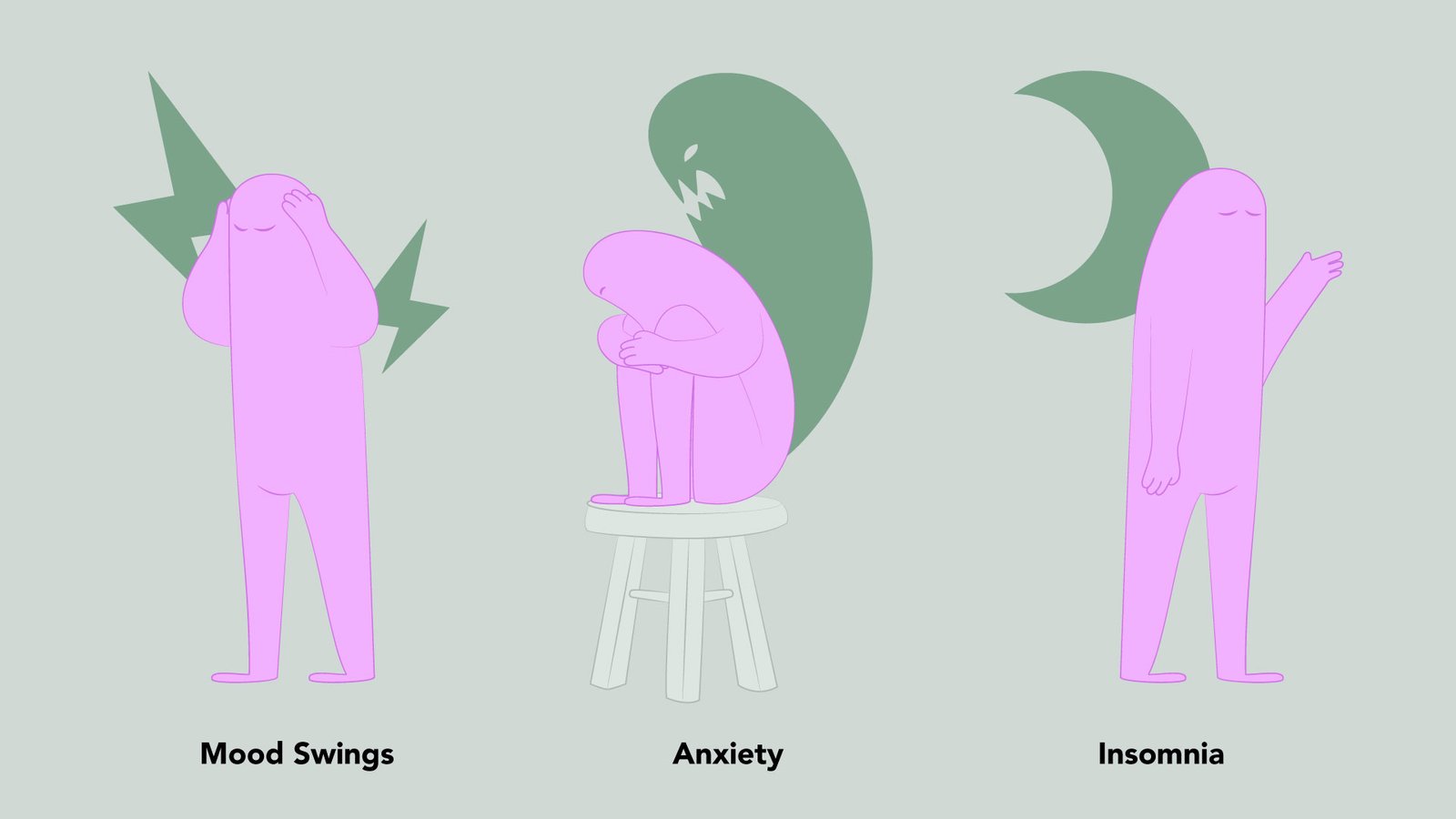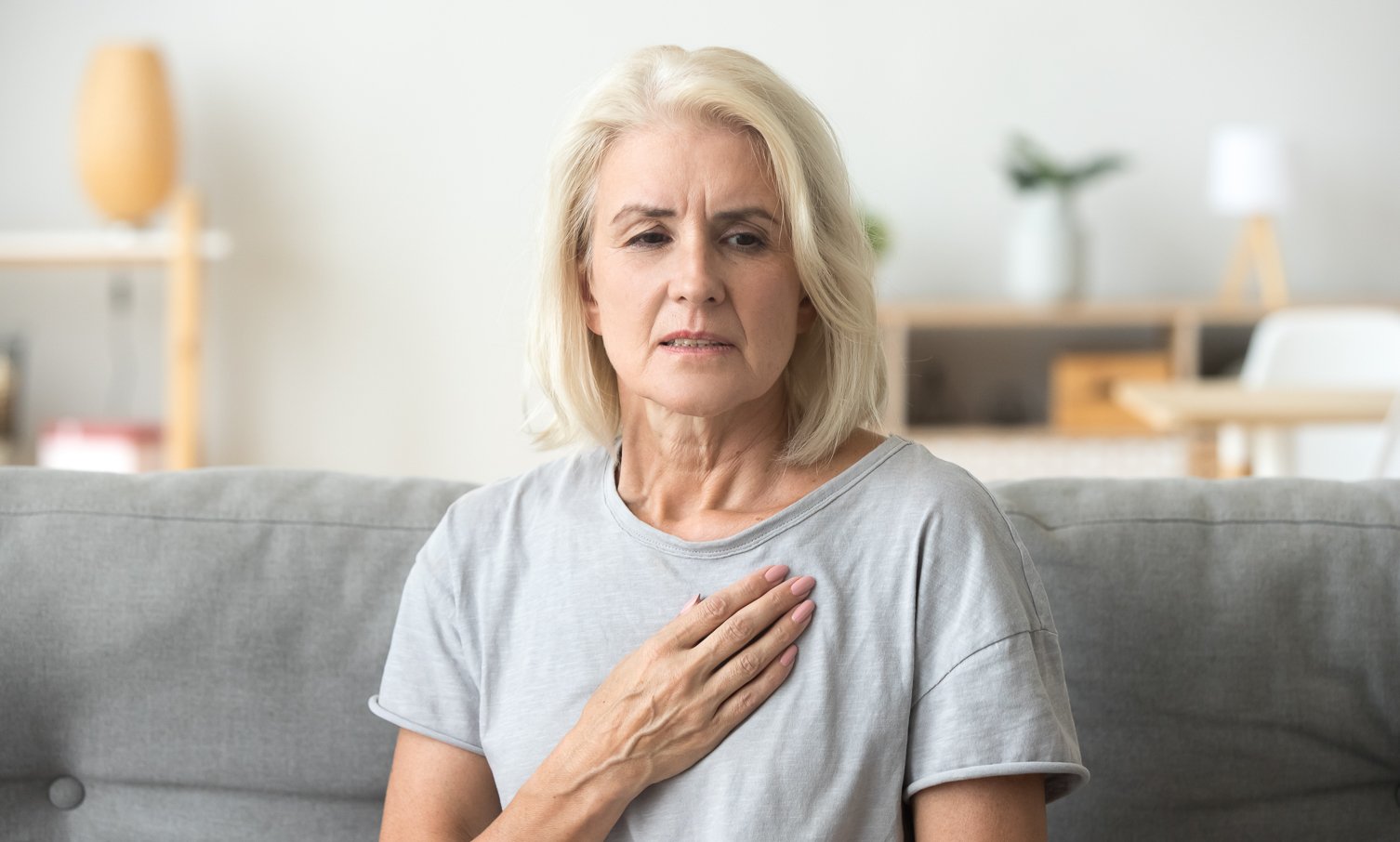Is This Normal? Postmenopausal Symptoms Explained
Reading time 13 min

Reading time 13 min

One moment, you’re throwing off the blankets because it feels like your whole body is on fire, and the next, you’re feeling a wave of sadness without any reason. If you’ve ever wondered whether what you’re experiencing is normal, here’s postmenopausal symptoms explained.
It’s easy to feel like you’re losing control, but many women are right there with you. In fact, 70% to 95% of us have/will experience postmenopausal symptoms1, 2.
What are common postmenopausal symptoms?
Postmenopausal symptoms can include hot flashes, mood swings, cognitive changes, joint pain, vaginal dryness, heart health risks, and osteoporosis. Understanding these changes helps manage your health.

Postmenopause can feel like a rollercoaster, with a mix of symptoms that range from hot flashes to mood swings, and even unexpected changes like dry skin or joint aches1, 2, 3. But the ride doesn’t have to be bumpy! Learn how to manage these symptoms and take back control with expert tips and science-backed strategies that can make life smoother and more enjoyable.
Vasomotor Symptoms (VMS) are the most common and recognizable signs of menopause. These are directly linked to the hormonal changes your body is going through, especially the drop in estrogen. This drop affects the hypothalamus, the part of your brain responsible for regulating body temperature.
When estrogen levels fluctuate, the hypothalamus gets “confused”, often overreacting to minor temperature changes and making you feel overheated out of nowhere. It’s like your internal thermostat is malfunctioning, which is why you might suddenly break into a sweat, even in the middle of a cool day8, 10.
Almost half of us going through menopause will feel easily irritated. You might notice yourself losing patience with your family, friends, or coworkers, and feeling more tired or down than usual. These emotional shifts can leave you feeling on edge, nervous, or stressed, and sometimes even more frustrated than you’d like to admit13.

Many women notice changes in their memory and focus. You might find it harder to remember words or numbers, misplace things like your keys more often, or struggle to concentrate. For some women, these changes can even feel a bit like attention deficit symptoms, where staying focused is a challenge. The cognitive changes that happen during menopause are not the same as dementia. In fact, dementia before the age of 64 is quite rare20.
As estrogen levels drop during menopause, it can lead to thinning and drying of the tissues in your vaginal and urinary tract. The lack of natural lubrication and weakened pelvic floor muscles can make these issues more noticeable, leaving you more prone to discomfort and infections18, 19.
Osteoporosis is a condition where bones become weak and brittle due to a loss of bone density and quality. This happens when the body loses more bone tissue than it can replace, making bones more fragile and likely to break, even from minor falls or injuries.
Shifting hormones, especially as estrogen levels drop, often leads to more fat being stored around your midsection. It’s common to see an increase in waist size and body mass index (BMI) during this time, even if you haven’t changed your habits.
Lower estrogen levels, and a relative increase in male hormones, affect your skin and hair. Your body produces less collagen, making your skin thinner, drier, and more prone to wrinkles. You may also notice more facial hair, thinning hair on your scalp, and even brittle nails as your hormones continue to change.
Approximately 32% of women report joint pain, stiffness, and swelling (osteoarthritis), especially in the knees and hands.

After menopause, cardiovascular issues can become more common because estrogen is no longer there to help protect your heart and blood vessels. Estrogen helps keep blood vessels healthy, so when the levels drop, the risk of heart problems like heart attacks or angina increases. Women often experience different symptoms compared to men, such as fatigue, nausea, or shortness of breath. These signs can sometimes delay diagnosis23.
Sarcopenia is the gradual loss of muscle mass and strength that happens as we age, and it speeds up during postmenopause. This can lead to gaining more body fat and feeling less physically strong than before.
Dry eye disease is common during postmenopause, most likely due to androgen hormone (e.g. testosterone) levels drop24.
When estrogen levels drop, it affects your mouth the same way it does in your vagina. The tissue becomes thinner and weaker, making it more prone to injuries and infections. In addition, when estrogen and progesterone levels drop, it can change how much saliva you produce and its thickness. This can lead to issues with your teeth and gums, increasing the risk of cavities and gum disease25, 9.
Breast tenderness affects 3.5% of women. It may cause the breasts to feel tender, swollen, or painful, though it typically diminishes as hormone levels stabilize postmenopause2.
As you read through all these symptoms, you probably thought, “I have most of them, if not all.” It can feel overwhelming and even isolating. But here’s the truth: you are not alone, and it’s all biology, baby!
I personally find it a relief that it’s not “in my head,” as some doctors might explain away. The symptoms have a very clear and solid basis in biology. Postmenopause can be a time of transition filled with changes that affect almost every part of your body, from hot flashes and heart palpitations to dry skin and unexpected weight gain.
While it’s tempting to downplay or ignore these changes, doing so could mean missing out on the chance to set yourself up for better long-term health. Whether it’s your heart, bones, or cognitive function, the actions you take today will impact how you feel tomorrow.
Incorporating daily habits like regular exercise, a balanced diet, and stress management can significantly improve your quality of life. These might sound like cliché tips, but they’re proven to help mitigate many of the symptoms you’re experiencing. Ultimately, postmenopause is another chapter in your life, not an end. It’s about understanding what your body needs now and adapting so that you can continue to live vibrantly.
Dr. Jūra Lašas
1.
Avis, N. et al. Vasomotor Symptoms Across the Menopause Transition: Differences Among Women. (2018) https://doi.org/10.1016/j.ogc.2018.07.005
2.
Nasreen, S. Symptoms of Menopause. (2019) https://doi.org/10.5772/intechopen.88572
3.
Brunner, R. et al. Menopausal symptom experience before and after stopping estrogen therapy in the Women’s Health Initiative randomized, placebo-controlled trial. Menopause. (2010) https://doi.org/10.1097/gme.0b013e3181d76953
4.
Col, N. et al. Menopause. (2009) https://doi.org/10.7326/0003-4819-150-7-200904070-01004
5.
Brunner, R. et al. Menopausal symptom experience before and after stopping estrogen therapy in the Women’s Health Initiative randomized, placebo-controlled trial. (2010) https://doi.org/10.1097/gme.0b013e3181d76953
6.
Thurston, R. et al. Vasomotor Symptoms and Menopause: Findings from the Study of Women’s Health across the Nation. (2011) https://doi.org/10.1016/j.ogc.2011.05.006
7.
Soules, M. et al. Executive summary: stages of reproductive aging workshop (STRAW). (2001) https://doi.org/10.1016/S0015-0282(01)02909-0
8.
Politi, M. et al. Revisiting the Duration of Vasomotor Symptoms of Menopause: A Meta-Analysis. (2008) https://doi.org/10.1007/s11606-008-0655-4.
9.
Meurman, J. et al. The menopause and oral health. (2009) https://doi.org/10.1016/j.maturitas.2009.02.009.
10.
Rapkin, A. Vasomotor symptoms in menopause: physiologic condition and central nervous system approaches to treatment. (2006) https://doi.org/10.1016/J.AJOG.2006.05.056.
11.
Sheng, Y. et al. Review of menopausal palpitations measures. (2021) https://doi.org/10.1186/s40695-021-00063-6
12.
Carpenter, J. et al. A Systematic Review of Palpitations Prevalence by Menopausal Status. (2021) https://doi.org/10.1007/s13669-020-00302-z
13.
Zinnat Ara Nasreen, S. Symptoms of Menopause. (2019) https://doi.org/10.5772/intechopen.88572
14.
Cohen, L. et al. Diagnosis of management of mood disorder during the menopausal transition. (2005) https://doi.org/10.1016/j.amjmed.2005.09.042
15.
Sanyaolu, L. et al. Impact of Menopausal Status and Recurrent UTIs on Symptoms, Severity, and Daily Life: Findings from an Online Survey of Women Reporting a Recent UTI. (2023) https://doi.org/10.3390/antibiotics12071150.
16.
Noirrit-Esclassan, E. et al. Critical Role of Estrogens on Bone Homeostasis in Both Male and Female: From Physiology to Medical Implications. (2021) https://doi.org/10.3390/ijms22041568
17.
Santos, L. et al. Exercise and bone health across the lifespan. (2017). https://doi.org/10.1007/s10522-017-9732-6
18.
Zinnat Ara Nasreen, S. Symptoms of Menopause. (2019) https://doi.org/10.5772/intechopen.88572
19.
Santoro, N. et al. Menopausal Symptoms and Their Management. (2015) https://doi.org/10.1016/j.ecl.2015.05.001
20.
Maki, P. et al. Brain fog in menopause: a health-care professional’s guide for decision-making and counseling on cognition. (2022) https://doi.org/10.1080/13697137.2022.2122792
21.
Maki, P. et al. A research primer for studies of cognitive changes across the menopause transition. (2021) https://doi.org/10.1080/13697137.2021.1905625
22.
Mosconi, L. et al. Increased Alzheimer’s risk during the menopause transition: A 3-year longitudinal brain imaging study. (2018) https://doi.org/10.1371/journal.pone.0207885
23.
Cardeillac, M. et al. Symptoms of Infarction in Women: Is There a Real Difference Compared to Men? (2022) https://doi.org/10.3390/jcm11051319
24.
Sriprasert, I. et al. Dry eye in postmenopausal women: a hormonal disorder. (2016) https://doi.org/10.1097/GME.0000000000000530
25.
Ciesielska, A. et al. Changes in the Oral Cavity in Menopausal Women—A Narrative Review. (2021) https://doi.org/10.3390/ijerph19010253